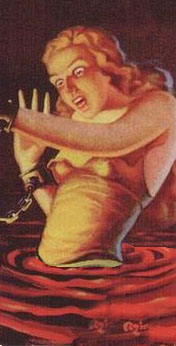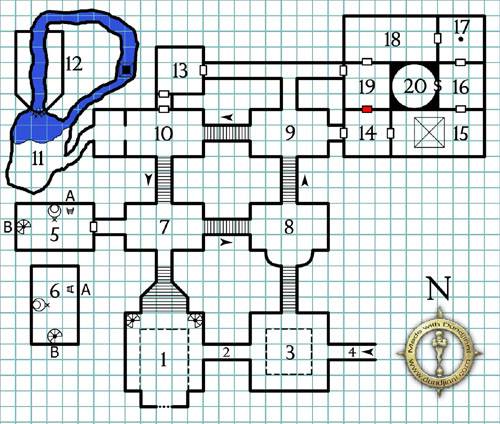More startling even than that diabolic chuckle was the scream that rose at my very elbow from the salt-compounded sand – the scream of a woman possessed by some atrocious agony, or helpless in the grip of devils. Turning, I beheld a veritable Venus, naked in a white perfection that could fear no scrutiny, but immersed to her navel in the sand. Her terror-widened eyes implored me and her lotus hands reached out with beseeching gesture.
The Abominations of Yondo, Clark Ashton Smith
 The honeytrap is a roper-like creature which relies on deceit and camouflage to trap its prey. The upper half of its body bears the appearance of a beautiful young maiden, but this beauty is wrapped around a mass of tentacular horror. The honeytrap’s favored tactic is to secrete a corrosive chemical capable of rendering even solid rock into a quicksand-like liquiesence. When its prey draws near, the honeytrap will cry in terror and plead for their aid. It will wait until they are at their most vulnerable before striking: Its sternum will part into a ravenous maw, exuding a half dozen coiled tentacles which will burst forth and wrap themselves lethally around the honeytrap’s would-be saviors.
The honeytrap is a roper-like creature which relies on deceit and camouflage to trap its prey. The upper half of its body bears the appearance of a beautiful young maiden, but this beauty is wrapped around a mass of tentacular horror. The honeytrap’s favored tactic is to secrete a corrosive chemical capable of rendering even solid rock into a quicksand-like liquiesence. When its prey draws near, the honeytrap will cry in terror and plead for their aid. It will wait until they are at their most vulnerable before striking: Its sternum will part into a ravenous maw, exuding a half dozen coiled tentacles which will burst forth and wrap themselves lethally around the honeytrap’s would-be saviors.
The honeytrap prefers to lure its victims into a danerous mixture of complacency and chivalry before striking, but those seeking to flee a ravenous honeytrap may be shocked as it wrenches itself free from its muck-ridden hunting grounds and pursues them with great speed upon a second tumultuous mass of tentacles extruding from its “maiden” waist.
HONEYTRAP CR 8
CE Large Magical Beast
Senses: darkvision 60 ft., low-light vision, Listen +13, Spot +13
Init: +5 (+1 Dex, +4 Improved Initiative)
Languages: Common, Elven
AC: 24, touch 10, flat-footed 23 (-1 size, +1 Dex, +14 natural)
Hit Points: 85 HD: 10d10+30
Fort +10, Ref +8, Will +8
Speed: 40 ft.
Melee: bite +13 (1d6+6)
Ranged: 6 strands +11 ranged touch (drag and weakness)
Space: 5 ft. Reach: 5 ft. (30 ft. with strand)
Base Atk: +10 Grapple: +14
Special Actions: quicksand liquiesence
Metamagic Feats: (spontaneous casters only)
Str 19, Dex 13, Con 17, Int 12, Wis 11, Cha 17
Special Qualities: darkvision 60 ft., low-light vision
Feats: Alertness, Improved Initiative, Iron Will, Weapon Focus (strand)
Skills: Climb +12, Hide +10*, Listen +13, Spot +13
Treasure: Standard
Advancement: 11-15 HD (Medium); 16-30 (Large)
Level Adjustment: —
Drag (Ex): If a honeytrap hits with a strand attack, the strand latches onto the opponent’s body. This deals no damage, but drags the struck opponent 5 feet closer each subsequent round (provoking no attack of opportunity) unless that creature breaks free, which requires an Escape Artist check (DC 23) or a Strength check (DC 19). (The DCs are Strength-based, and the Escape Artist check includes a +4 racial bonus.)
Drag and Bite: A honeytrap can draw a creature within 5 feet of itself and bite with a +4 attack bonus in the same round. A strand has 10 hit points and can be attacked by making a successful sunder attempt. However, attacking a honeytrap’s strand does not provoke an attack of opportunity. If the strand is currently attached to a target, the roper takes a -4 penalty on its opposed attack roll to resist the sunder attempt. Severing a strand deals no damager to the honeytrap.
Drag and Drown: A honeytrap who has drawn a victim into its quicksand will often try to drown them. A honeytrap can draw a creature 5 feet and attempt to drown them by making an opposed grapple check. If the check succeeds, the victim is pushed below the surface of the quicksand.
Strands (Ex): A honeytrap can extrude up to six strands at once, and they can strike up to 30 feet away (no range increment). If a strand is severed, a honeytrap can extrude a new one on its next turn as a free action.
Quicksand Liquiesence (Ex): A honeytrap can turn a 10 ft. radius of earth, dirt, or stone into quicksand in 1d4 minutes by excreting a powerful, acidic chemical. If a honeytrap is slain, moves, or stops excreting the chemical, the ground will re-solidify within 1d4 hours.
Quicksand requires a Survival check (DC 8′) to spot. The momentum of a running or charging character will carry them 1d2x5 feet into the quicksand. Characters in quicksand must make a Swim check (DC 10) every round to simply tread water in place, or a DC 15 check to move 5 feet in whatever direction desired. If a trapped character fails this check by 5 or more, he sinks below the surface and begins to drown whenever he can no longer hold his breath (see Swim skill). Characters below the surface of a bog may swim back to the surface with a successful Swim check (DC 15, +1 per consecutive round of being under the surface).
Pulling a trapped character out of quicksand often requires a branch, spear haft, rope, or similar tool to reach the victim with one end of it. The character performing the rescue must make a Strength check (DC 15) to pull the victim out, while the victim must succeed at a Strength check (DC 10) to hold onto the branch, pole, or rope. If the victim fails to hold on, he must immediately make a Swim check (DC 15) to remain above the surface. If both checks succeed, the victim is pulled 5 feet closer to safety.
Weakness (Ex): A honeytrap’s strands sap an opponent’s strength. Anyone grabbed by a strand must succeed on a Fortitude save (DC 18) or take 1d8 points of Strength damage. The DC is Constitution-based.
Skills: *Honeytraps have a +8 racial bonus to Hide checks if they are submerged in quicksand or similarly concealed.
This material is covered by the Open Gaming License.


















